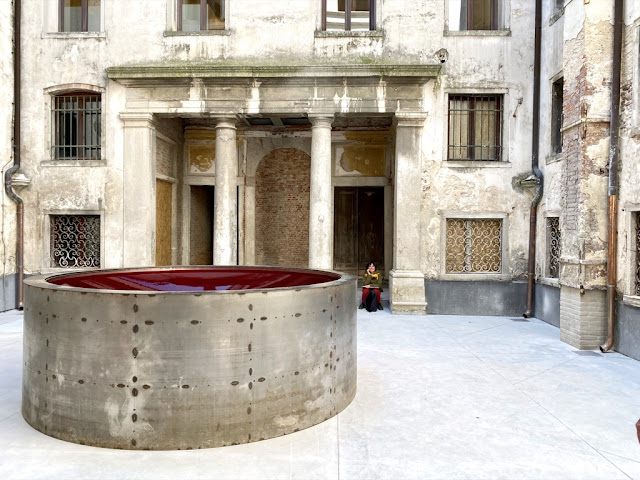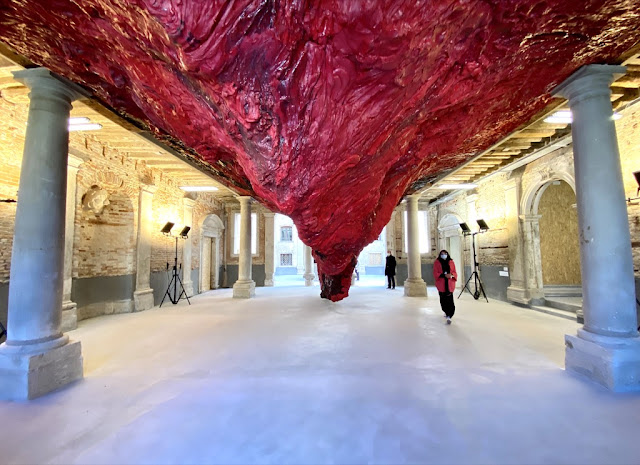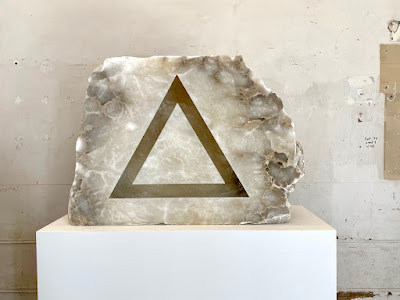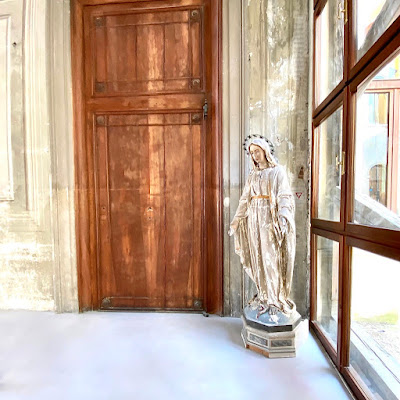"Kapoor creates works that are happening as we experience them. Throughout all of the spaces of
this exhibition at the Gallerie dell’Accademia and Palazzo Manfrin, there is process and temporality
on display and in action. These works exist in a continuous state of becoming, we are invited to
witness these objects at just one moment in the process of their generation or de-generation."
Taco Dibbits
curator
Gallerie dell'Accademia + Palazzo Manfrin
Anish Kapoor
Internationally acclaimed artist Anish Kapoor is the first British artist to be honoured with a major
two part exhibition - at the Gallerie dell’Accademia and Palazzo Manfrin - until October 9 - which is curated by art historian Taco Dibbits, General Director of the Rijksmuseum in Amsterdam. The exhibition, which includes about 60 works, has retrospective elements alongside newer
bodies of work, presenting key moments in the artist’s career. Ground-breaking new works,
created using carbon nanotechnology, are shown for the first time, as well as recent
paintings and sculptures that are testament to the vitality and visionary nature of Kapoor’s
current practice.
Gallerie dell'Accademia - Anish Kapoor
The Unremembered - 2020
The Benighted - 2022 - The Benighted III - 2021
This interaction of science and art has created works that sit within an age-old language of painting,
that alongside installations like Shooting into the Corner and new paintings enter a
complex dialogue with the Gallerie dell’Accademia’s historical collection. Perhaps more explicitly
than ever, this exhibition looks to a language of the interior that has always been central to Kapoor's
practice.
Gallerie dell'Accademia - Anish Kapoor
Shooting into the Corner - 2008-2009
"Anish Kapoor has built his whole oeuvre on
investigating the absolute essence of art in it's constituent inner elements: form, pigment, perspective,
light and its absence,facilitating in this creative investigation a stimulating dialogue with the art of the
great Venetian Renaissance masters represented in the museum: Bellini,Titian, Tintoretto,Veronese.”
Giulio Manieri Elia
Director - Gallerie dell'Accademia
Giulio Manieri Elia, Anish Kapoor, and Art Historian and curator Taco Dibbits
Giorgione - La Tempesta
Giorgione's La Tempesta was housed in Count Girolamo Manfrin's palazzo's picture gallery in the nineteenth century, at the time one of Venice's major tourist attractions visited by among others Antonio Canova, Lord Byron,
John Ruskin and Edouard Manet. When the works in the
collection were sold, after the death of Manfrin, the heritage of the Gallerie dell'Accademia was
enriched with twenty-one paintings including masterpieces such as Giorgione’s La Tempesta and La Vecchia and works by Mantegna, Memling, Nicolo di Pietro, Girolamo Savoldo and
Moretto. The 18th-century Palazzo Manfrin, which had been empty for many years, was recently acquired by
the Anish Kapoor Foundation.
Gallerie dell'Accademia - Anish Kapoor
Non-Object Black - installation view
Perhaps more explicitly
than ever, this exhibition looks to a language of the interior that has always been central to Kapoor's
practice. In Pregnant White Within Me the architecture of the gallery is distended, suggesting
a re-shaping of the boundaries between body, building and being. Throughout the exhibition
Kapoor's works absorb and extend the space within and around them into uncanny realms,
transforming the rooms of the Gallerie dell'Accademia into sites for the magical - going beyond the
display of objects.
Gallerie dell'Accademia - Anish Kapoor
Pregnant White Within Me - 2022
Ground-breaking new works,
created using carbon nanotechnology, are shown for the first time,
The skin of the object as veil between the inner and outer world has always been a potent presence in the artist’s practice, and at the Gallerie dell’Accademia, sculptures made with Vantablack push this dynamic into radical new territory, in forms that both appear and disappear before our eyes. In these works Kapoor proposes that if the motif of the fold in Renaissance painting was a sign of being, in their obliteration of the contour and edge we are offered nothing less than the possibility to go beyond being. More
unknown forces emerge through a further series of mysterious black
works, some embedded in the wall of the gallery, that further explore
darkness as a physical and psychic reality. Alongside these works Kapoor’s most recent paintings are strongly debuted, setting up a dynamic dialogue with both the Gallerie’s art historical collection, and his own sculptural language.
Gallerie dell'Accademia - Anish Kapoor
Mother as a Mountain - Black - 1985
Palazzo Manfrin - Anish Kapoor
Turning Water into Mirror, Blood into Sky - 2003
The second venue of Anish Kapoor’s dual exhibition begins with the monumental new work Mount Moriah at the Gate of the Ghetto, protruding from the ceiling of the entrance hall and created specifically for the partially renovated spaces of Palazzo Manfrin where some of the most famous
works in the Gallerie dell’ Accademia’s collection originally hung.
This pendulous mass of silicone and paint guides visitors through to an equally challenging set of rooms.
Palazzo Manfrin - Anish Kapoor
Mount Moriah at the Gate of the Ghetto - 2022
"...in which a monochrome blue digger transports tonnes of
red earth
in an epic act of displacement."
Palazzo Manfrin - Anish Kapoor
Destierro - 2017
Destierro - 2017
"Subtleties of Venetian light are at play in ethereal, geometrical works carved from natural alabaster while the deep, lagoon blue pigment of Kapoor’s early void hemispheres provide moments of meditative respite."
Palazzo Manfrin - Anish Kapoor
Gate II - 2020
Gate III - 2021
Split in Two Like a Fish For Frying - 2022
Installation View Non- Object Black - Kapoor Black
Vertigo - 2006
Palazzo Manfrin - Anish Kapoor
Sky Below 2022 - Painting ƃuᴉʇuᴉɐd - 2021 - mirror ɹoɹɹᴉɯ - 2017
Portrait of Pink - 2019 - Portrait of Pink II - 2019
- Portrait of Pink III - 2019
Palazzo Manfrin - Anish Kapoor
Symphony for a Beloved Sun - 2022
Palazzo Manfrin
The Catalogue
The exhibition is accompanied by a catalogue published by Marsilio with essays by: Gil Andijar; Homi K.Bhabha; Linda Borean; Giuseppe Civitarese; Mario Codognato; Waldemar Januszczak; Norman Rosenthal; Carlo Rovelli and Michele Tavola.


























